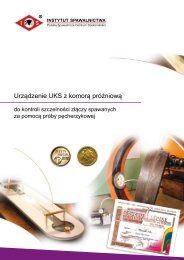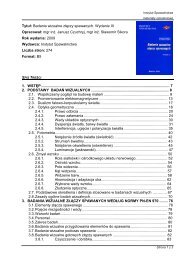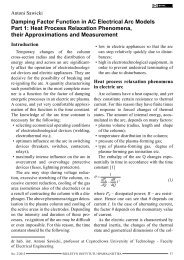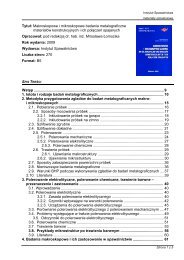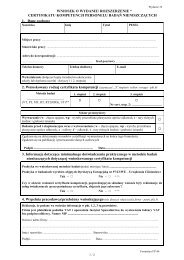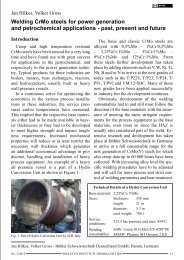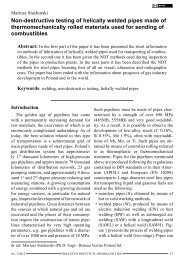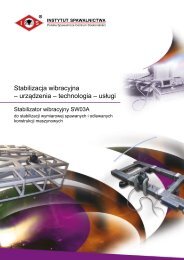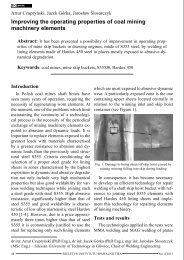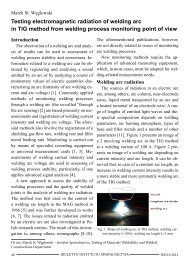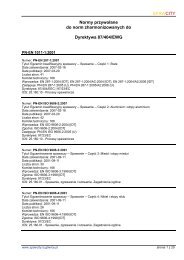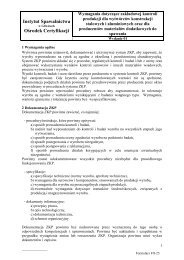Biuletyn Instytutu Spawalnictwa No. 01/2012
Biuletyn Instytutu Spawalnictwa No. 01/2012
Biuletyn Instytutu Spawalnictwa No. 01/2012
You also want an ePaper? Increase the reach of your titles
YUMPU automatically turns print PDFs into web optimized ePapers that Google loves.
welding slag (i.e. slag formed by molten electrode<br />
covering) in the welds of the letters “B”<br />
(from the front side of the sign), “E” (from the<br />
front side of the sign), “I” (from the front and<br />
back side of the sign, from the bottom) in the<br />
word ARBEIT, “M” (from the front side, from<br />
the bottom of the sign, from the left side) and<br />
the letter “C” (from the front side, from the<br />
bottom of the sign), among others. On the basis<br />
of this inspection it was possible to ascertain<br />
that the welded joints were welded manually<br />
with covered electrodes. Removal of the<br />
paint revealed welding imperfections which<br />
had been formed during the original welding<br />
of the historic sign. These faults included a<br />
burn-through in the upper joint of the letter<br />
“A” in the word ARBEIT and a gas pore in<br />
the welded joint of the bottom left base of the<br />
letter “R” in the same word, from the front<br />
side of the sign.<br />
On the basis the visual inspection of the<br />
sign, after its straightening by the artistic metalwork<br />
company EDEX-POL in Sułkowice<br />
and sand-blast cleaning of the zone directly<br />
adjacent to the area of the planned welding,<br />
a detailed list of the necessary repair welding<br />
was prepared. The scope of the work included<br />
the production of butt joints of the upper and<br />
lower pipes of the sign, welding the sign-fastening<br />
elements, as well as welding the fragments<br />
which had cracked and were torn off<br />
[6].<br />
Tests of historic sign pipe after hot<br />
straightening<br />
The damaged fragments of the sign underwent<br />
cold or hot straightening. According<br />
to information provided by the Conservation<br />
Section, in the case of hot straightening the<br />
elements were first heated up to a temperature<br />
of 830°C÷1050°C (orange colour of steel incandescence)<br />
and cooled quickly afterwards.<br />
Visual inspection did not reveal any cracks<br />
in the places adjacent to the area which had<br />
been heated.<br />
Tests of the microstructure of the historic<br />
sign pipe were conducted using the damaged<br />
section of the lower pipe, adjacent to the letter<br />
“I” (3DP acc. to Fig. 2) in the word FREI.<br />
The section in question underwent hot straightening<br />
and next, on the basis of the type<br />
and size of the damage, was qualified for a<br />
removal and replacement by a 50 mm-long<br />
insert.<br />
Before microstructural analysis the pipe<br />
material was tested for the contents of carbon,<br />
sulphur and phosphorus, which amounted to<br />
0.038%, 0.052% and 0.069% respectively.<br />
The above results, along with the results cited<br />
according to the study [1], confirmed that<br />
the chemical composition of the pipe being<br />
tested corresponded to low-carbon unalloyed<br />
structural steel. For this reason, after hot straightening<br />
followed by cooling in water, the<br />
material of the pipe should be free from disadvantageous<br />
hardened structures. In order<br />
to verify the above statement it was necessary<br />
to carry out microscopic metallographic<br />
examination of the pipe material, revealing<br />
the presence of ferritic structure with numerous<br />
non-metallic inclusions. The material<br />
of the pipe after hot straightening and fast<br />
water cooling did not reveal any hardened<br />
structures. The hardness of the pipe material<br />
measured in the metallographic specimen<br />
was between 119 HV10 and 184 HV10. The<br />
microscopic examination and hardness measurements<br />
confirmed that post-straightening<br />
repair welding did not require any additional<br />
heat treatment.<br />
28 BIULETYN INSTYTUTU SPAWALNICTWA<br />
NR <strong>01</strong>/2<strong>01</strong>2



